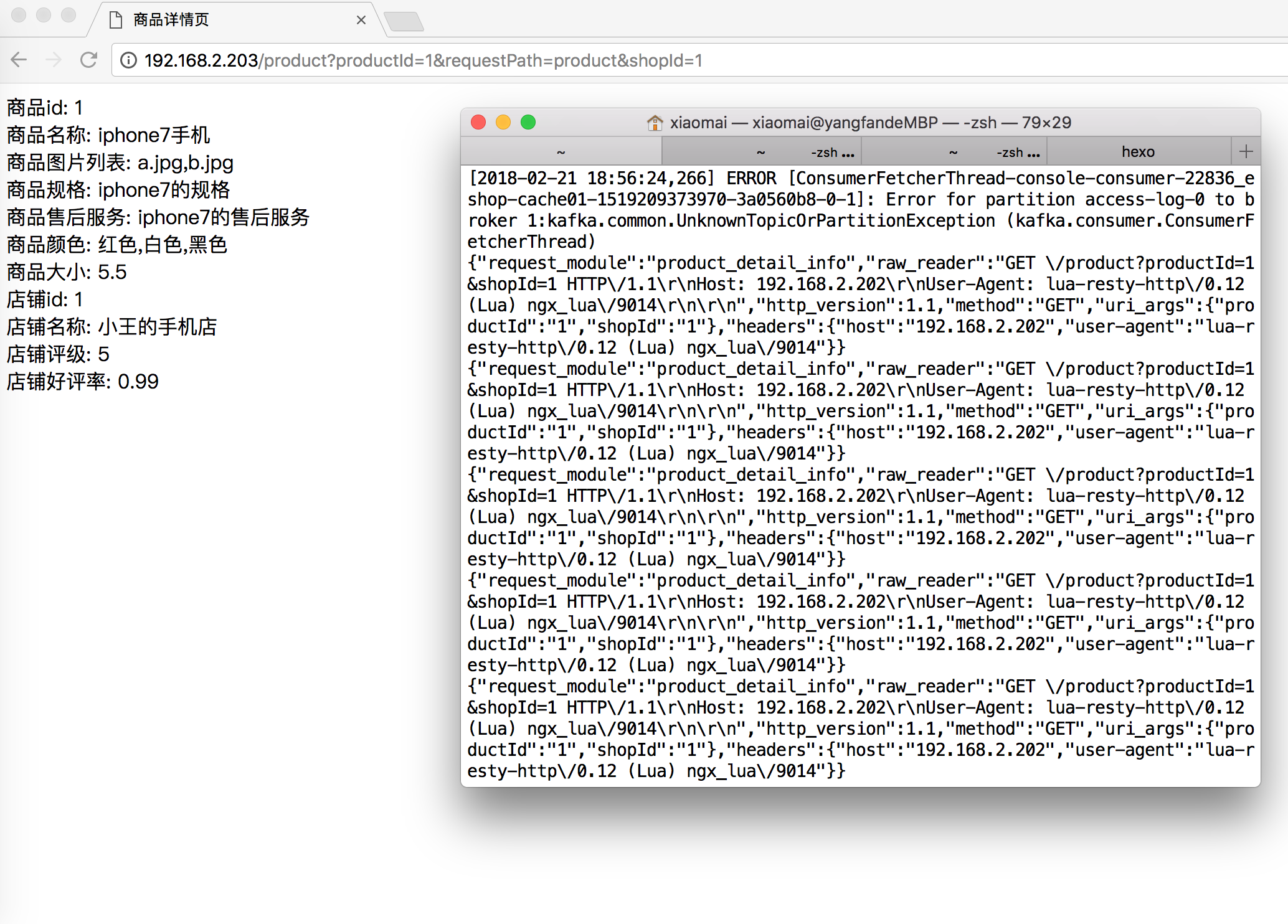此为龙果学院课程笔记,记录以供以后翻看
缓存预热 系统刚上线的时候,redis里面是没有数据的,如果这个时候高并发的流量过来全部跑到mysql,那么mysql肯定就挂掉了。所以我们需要缓存预热
提前给redis中灌入部分数据,再提供服务
肯定不可能将所有数据都写入redis,因为数据量太大了,第一耗费的时间太长了,第二根本redis容纳不下所有的数据
需要根据当天的具体访问情况,实时统计出访问频率较高的热数据
然后将访问频率较高的热数据写入redis中,肯定是热数据也比较多,我们也得多个服务并行读取数据去写,并行的分布式的缓存预热
然后将灌入了热数据的redis对外提供服务,这样就不至于冷启动,直接让数据库裸奔了
缓存预热的方案和流程:
1、 nginx+lua将访问流量上报到kafka中
要统计出来当前最新的实时的热数据是哪些,我们就得将商品详情页访问的请求对应的流量,日志,实时上报到kafka中。
2、 storm从kafka中消费数据,实时统计出每个商品的访问次数,访问次数基于LRU内存数据结构的存储方案
如何使用storm?
优先用内存中的一个LRUMap去存放,这样做性能高,而且没有外部依赖。否则依赖redis的话,我们本就是要防止redis挂掉数据丢失的情况,就不合适了; 用mysql,扛不住高并发读写; 用hbase,hadoop生态系统,维护麻烦,太重了。其实我们只要统计出最近一段时间访问最频繁的商品,然后对它们进行访问计数,同时维护出一个前N个访问最多的商品list即可。计算好每个task大致要存放的商品访问次数的数量,计算出大小。然后构建一个LRUMap,apache commons collections有开源的实现,设定好map的最大大小,就会自动根据LRU算法去剔除多余的数据,保证内存使用限制。即使有部分数据被干掉了,然后下次来重新开始计数,也没关系,因为如果它被LRU算法干掉,那么它就不是热数据,说明最近一段时间都很少访问了。
3、每个storm task启动的时候,基于zk分布式锁,将自己的id写入zk同一个节点中
4、每个storm task负责完成自己这里的热数据的统计,每隔一段时间,就遍历一下这个map,然后维护一个前3个商品的list,更新这个list
5、写一个后台线程,每隔一段时间,比如1分钟,都将排名前3的热数据list,同步到zk中去,存储到这个storm task对应的一个znode中去
6、我们需要一个服务,比如说,代码可以跟缓存数据生产服务放一起,但是也可以放单独的服务,这个服务可能部署了很多个实例。每次服务启动的时候,就会去拿到一个storm task的列表,然后根据taskid,一个一个的去尝试获取taskid对应的znode的zk分布式锁。如果能获取到分布式锁的话,那么就将那个storm task对应的热数据的list取出来,然后将数据从mysql中查询出来,写入缓存中,进行缓存的预热。因为是多个服务实例,分布式的并行的去做,都基于zk分布式锁做了协调(没有并发冲突问题),分布式并行缓存的预热,效率很高。
基于nginx+lua完成商品详情页访问流量实时上报kafka的开发 在nginx这一层,接收到访问请求的时候,就把请求的流量上报发送给kafka。这样的话,storm才能去消费kafka中的实时的访问日志,然后去进行缓存热数据的统计。用的技术方案非常简单,从lua脚本直接创建一个kafka producer,发送数据到kafka。
1 2 3 4 5 cd /usr/local wget https://github.com/doujiang24/lua-resty-kafka/archive/master.zip yum install -y unzip unzip master.zip cp -rf /usr/local /lua-resty-kafka-master/lib/resty /usr/hello/lualib
接着修改脚本,开始写记录日志并发送到kafka:
1 2 3 4 5 6 7 8 9 10 11 12 13 14 15 16 17 18 19 20 21 22 23 24 25 26 27 28 29 30 31 32 33 34 35 36 37 38 39 40 41 42 43 44 45 46 47 48 49 50 51 52 53 54 55 56 57 58 59 60 61 62 63 64 65 66 67 68 69 70 71 72 73 74 75 76 77 78 79 80 81 82 83 84 85 86 87 88 local cjson = require ("cjson" )local producer = require ("resty.kafka.producer" )local broker_list = { {host="192.168.2.201" , port=9092 }, {host="192.168.2.202" , port=9092 }, {host="192.168.2.203" , port=9092 } } local log_json = {}log_json["request_module" ] = "product_detail_info" log_json["headers" ] = ngx.req.get_headers() log_json["uri_args" ] = ngx.req.get_uri_args() log_json["body" ] = ngx.req.read_body() log_json["http_version" ] = ngx.req.http_version() log_json["method" ] =ngx.req.get_method() log_json["raw_reader" ] = ngx.req.raw_header() log_json["body_data" ] = ngx.req.get_body_data() local message = cjson.encode(log_json); local uri_args = ngx.req.get_uri_args()local productId = uri_args["productId" ]local shopId = uri_args["shopId" ]local async_producer = producer:new(broker_list, {producer_type="async" })local ok, err = async_producer:send("access-log" , productId, message)local cache_ngx = ngx.shared.my_cachelocal productCacheKey = "product_info_" ..productIdlocal shopCacheKey = "shop_info_" ..shopIdlocal productCache = cache_ngx:get(productCacheKey)local shopCache = cache_ngx:get(shopCacheKey)if productCache == "" or productCache == nil then local http = require ("resty.http" ) local httpc = http.new() local resp, err = httpc:request_uri("http://192.168.2.171:8080" ,{ method = "GET" , path = "/getProductInfo?productId=" ..productId }) productCache = resp.body cache_ngx:set(productCacheKey, productCache, 10 * 60 ) end if shopCache == "" or shopCache == nil then local http = require ("resty.http" ) local httpc = http.new() local resp, err = httpc:request_uri("http://192.168.2.171:8080" ,{ method = "GET" , path = "/getShopInfo?shopId=" ..shopId }) shopCache = resp.body cache_ngx:set(shopCacheKey, shopCache, 10 * 60 ) end local productCacheJSON = cjson.decode(productCache)local shopCacheJSON = cjson.decode(shopCache)local context = { productId = productCacheJSON.id, productName = productCacheJSON.name, productPrice = productCacheJSON.price, productPictureList = productCacheJSON.pictureList, productSpecification = productCacheJSON.specification, productService = productCacheJSON.service, productColor = productCacheJSON.color, productSize = productCacheJSON.size, shopId = shopCacheJSON.id, shopName = shopCacheJSON.name, shopLevel = shopCacheJSON.level, shopGoodCommentRate = shopCacheJSON.goodCommentRate } local template = require ("resty.template" )template.render("product.html" , context)
两台机器上都这样做,才能统一上报流量到kafka
修改配置:
在nginx.conf中,http部分,加入resolver 8.8.8.8;
在/usr/local/kafka/config/server.properties中加入advertised.host.name = 192.168.2.201(各kafka实例的ip),杀掉并重启三个kafka进程。nohup bin/kafka-server-start.sh config/server.properties &
启动eshop-cache缓存服务,因为nginx中的本地缓存可能不在了
下面试试消息是否上报成功,先创建kafka topic。
1 bin/kafka-topics.sh --zookeeper 192.168.2.201:2181,192.168.2.202:2181,192.168.2.203:2181 --topic access-log --replication-factor 1 --partitions 1 --create
访问:http://192.168.2.203/product?productId=1&requestPath=product&shopId=1
启动consumer,订阅access-log主题可以看到消息已经发送过来了。
1 bin/kafka-console-consumer.sh --zookeeper 192.168.2.201:2181,192.168.2.202:2181,192.168.2.203:2181 --topic access-log --from-beginning
基于Storm统计热数据
用Spout从kafka读取消息
Bolt提取productId发射到下一个Bolt
基于LRUMap统计热点访问的productId
将热点数据存入zookeeper
https://github.com/sail-y/eshop-storm
预热逻辑:
服务启动的时候,进行缓存预热
从zk中读取taskid列表
依次遍历每个taskid,尝试获取分布式锁,如果获取不到,快速报错,不要等待,因为说明已经有其他服务实例在预热了
直接尝试获取下一个taskid的分布式锁
即使获取到了分布式锁,也要检查一下这个taskid的预热状态,如果已经被预热过了,就不再预热了
执行预热操作,遍历productid列表,查询数据,然后写ehcache和redis
预热完成后,设置taskid对应的预热状态
https://github.com/sail-y/eshop-cache
基于nginx+lua+storm的热点缓存的流量分发策略自动降级解决方案 如果因为秒杀等或者抢购等原因,某一个商品访问量瞬间飙升,就算做了流量分发和缓存,因为hash策略所以同一个productId会被分发到同一个nginx服务器中。那么这就可能会导致nginx服务挂掉,这一台挂掉后别的服务上,然后也陆陆续续挂掉,导致整个系统不可用。
解决办法:
在storm中实时的计算出瞬间出现的热点
我们可以基于storm来计算热点数据,比如我们将访问的次数排序,将后面95%的数据访问量取一个平均值。这个时候要设定一个阈值,如果超出95%平均值的n倍,例如5倍,我们就认为是瞬间出现的热点数据,判断其可能在短时间内继续扩大的访问量,甚至达到平均值几十倍,或者几百倍,当发现第一个商品的访问次数,小于平均值的5倍,就安全了,就break掉这个循环。
流量分发nginx的分发策略降级
流量分发nginx加一个逻辑:每次访问一个商品详情页的时候,如果发现它是个热点,那么立即做流量分发策略的降级。降级成对这个热点商品,流量分发采取随机负载均衡发送到所有的后端应用nginx服务器上去。瞬间将热点缓存数据的访问从hash分发全部到一台nginx,变成了负载均衡发送到多台nginx上。
storm还需要保存下来上次识别出来的热点list
保存上次的热点数据,跟这次计算出的热点数据进行比较,那么就需要对某些数据进行热点取消,删除nginx本地缓存。
代码实战 https://github.com/sail-y/eshop-storm
HotProductFindThread.java新增的逻辑:
将LRUMap中的数据按照访问次数进行全局的排序
计算95%的商品访问次数的平均值
遍历排序后的商品访问次数,降序
如果某个商品是平均访问量的10倍以上,就认为是缓存的热点
将缓存热点数据推送到流量分发的nginx中
将获取到的换成你数据推送到nginx服务上
lua接口开发 将热点数据进行标记接口开发
之前流量分发的nginx服务是部署在192.168.2.203上面的,所以vi /usr/hello/hello.conf
1 2 3 4 5 6 7 8 9 10 11 12 13 14 15 16 17 18 19 server { listen 80 ; server_name _; location /hello { default_type 'text/html' ; content_by_lua_file /usr/hello/lua/hello.lua; } location /product { default_type 'text/html' ; content_by_lua_file /usr/hello/lua/distribute.lua; } location /hot { default_type 'text/html' ; content_by_lua_file /usr/hello/lua/hot.lua; } }
1 2 3 4 5 6 7 8 9 10 11 12 vi /usr/hello/lua/hot.lua local uri_args = ngx.req.get_uri_args()local product_id = uri_args["productId" ]local cache_ngx = ngx.shared.my_cachelocal hot_product_cache_key = "hot_product_" ..product_idcache_ngx:set (hot_product_cache_key, "true" , 60*60) /usr/servers/nginx/sbin/nginx -s reload
设置缓存数据接口开发
分别在201和201的nginx应用增加一个hot的配置
1 2 3 4 5 6 7 8 9 10 11 12 13 14 15 16 vi /usr/hello/hello.conf location /hot { default_type 'text/html' ; content_by_lua_file /usr/hello/lua/hot.lua; } vi /usr/hello/lua/hot.lua local uri_args = ngx.req.get_uri_args()local product_id = uri_args["productId" ]local product_info = uri_args["productInfo" ]local product_cache_key = "product_info_" ..product_idlocal cache_ngx = ngx.shared.my_cachecache_ngx:set (product_cache_key, product_info, 60*60)
自动降级代码开发 下面在distribute.lua里面开发自动降级的逻辑
取出之前在hot.lua中缓存的hot_product_cache_key
如果为true就不走hash算法进行流量分发了,走随机负载均衡算法。
1 2 3 4 5 6 7 8 9 10 11 12 13 14 15 local hosts = {"192.168.2.201" , "192.168.2.202" }local backend = "" local hot_product_key = "hot_product_" ..productIdlocal cache_ngx = ngx.shared.my_cachelocal hot_product_flag = cache_ngx:get(hot_product_key)if hot_product_flag == "true" then math .randomseed (tostring (os .time ()):reverse ():sub (1 , 7 )) local index = math .random (1 , 2 ) backend = "http://" ..hosts[index] else local hash = ngx.crc32_long(productId) local index = (hash % 2 ) + 1 backend = "http://" ..hosts[index] end
热点缓存消失自动识别和感知逻辑开发 https://github.com/sail-y/eshop-cache
HotProductFindThread.java
1 2 3 // 缓存热点消失,发送一个一个http请求到nginx取消热点缓存的标识 String url = "http://192.168.2.203/cancelHot?productId=" + productId; HttpClientUtils.sendGetRequest(url);
203上nginx的lua接口开发
1 2 3 4 5 6 7 8 9 10 11 12 13 14 15 16 17 18 vi hello.conf location /cancelHot { default_type 'text/html' ; content_by_lua_file /usr/hello/lua/cancelHot.lua; } cp lua/hot.lua lua/cancelHot.lua vi lua/cancelHot.lua local uri_args = ngx.req.get_uri_args()local product_id = uri_args["productId" ]local cache_ngx = ngx.shared.my_cachelocal hot_product_cache_key = "hot_product_" ..product_idcache_ngx:set (hot_product_cache_key, "false" , 60)
测试 手动将某个热点设置为热点:
1 http://192.168.2.203/hot?productId=1
然后访问:
1 http://192.168.2.203/product?productId=1&requestPath=product&shopId=1
可以看到当缓存变成热点以后,访问的服务是随机变化的。
因为代码里用了缓存,所以记得在203的上面vi conf/nginx.conf,在http模块下新增lua_shared_dict my_cache 128m;。
多访问几次不同的商品ID
用storm运行topology,观察日志是否正确
观察zookeeper里面的数据是否正确
1 2 3 zkCli.sh get /task-hot-product-list-4 [5,1,3]
storm日志:
1 2 3 4 5 6 7 8 2018-03-03 21:12:56.627 c.r.e.s.b.ProductCountBolt Thread-17 [INFO] 【HotProductFindThread计算出一份排序后的商品访问次数列表】 productCountListJSON=[{1:11},{3:1},{5:1},{9:1},{7:1}] 2018-03-03 21:12:56.637 c.r.e.s.b.ProductCountBolt Thread-16 [INFO] 【ProductCountThread计算出一份top3热门商品列表】zk path=/task-hot-product-list-4, topnProductListJSON=[1,3,5] 2018-03-03 21:12:56.677 c.r.e.s.b.ProductCountBolt Thread-17 [INFO] 【HotProductFindThread】计算出后95%访问次数的平均值 avgCount=1.0 2018-03-03 21:12:56.821 c.r.e.s.b.ProductCountBolt Thread-17 [INFO] 【HotProductFindThread】 发现一个新的热点 productId=1 2018-03-03 21:12:58.754 c.r.e.s.b.ProductCountBolt Thread-17 [INFO] http://192.168.2.201/hot?productId=1&productInfo=%7B%22id%22%3A1%2C%22name%22%3A%22iphone7%E6%89%8B%E6%9C%BA%22%2C%22price%22%3A5599.0%2C%22pictureList%22%3A%22a.jpg%2Cb.jpg%22%2C%22specification%22%3A%22iphone7%E7%9A%84%E8%A7%84%E6%A0%BC%22%2C%22service%22%3A%22iphone7%E7%9A%84%E5%94%AE%E5%90%8E%E6%9C%8D%E5%8A%A1%22%2C%22color%22%3A%22%E7%BA%A2%E8%89%B2%2C%E7%99%BD%E8%89%B2%2C%E9%BB%91%E8%89%B2%22%2C%22size%22%3A%225.5%22%2C%22shopId%22%3A1%2C%22modifiedTime%22%3A%222017-01-01+12%3A00%3A00%22%7D%0A 2018-03-03 21:12:58.787 c.r.e.s.b.ProductCountBolt Thread-17 [INFO] http://192.168.2.202/hot?productId=1&productInfo=%7B%22id%22%3A1%2C%22name%22%3A%22iphone7%E6%89%8B%E6%9C%BA%22%2C%22price%22%3A5599.0%2C%22pictureList%22%3A%22a.jpg%2Cb.jpg%22%2C%22specification%22%3A%22iphone7%E7%9A%84%E8%A7%84%E6%A0%BC%22%2C%22service%22%3A%22iphone7%E7%9A%84%E5%94%AE%E5%90%8E%E6%9C%8D%E5%8A%A1%22%2C%22color%22%3A%22%E7%BA%A2%E8%89%B2%2C%E7%99%BD%E8%89%B2%2C%E9%BB%91%E8%89%B2%22%2C%22size%22%3A%225.5%22%2C%22shopId%22%3A1%2C%22modifiedTime%22%3A%222017-01-01+12%3A00%3A00%22%7D%0A 2018-03-03 21:12:58.807 c.r.e.s.b.ProductCountBolt Thread-17 [INFO] 【HotProductFindThread】 保存上次热点数据 lastTimeHotProductList=[1] 2018-03-03 21:13:01.637 c.r.e.s.b.ProductCountBolt Thread-16 [INFO] 【ProductCountThread打印productCountMap的长度】size=5
然后访问几次别的商品,把平均数提高。
1 2 3 4 5 6 7 2018-03-03 21:15:01.948 c.r.e.s.b.ProductCountBolt Thread-16 [INFO] 【ProductCountThread计算出一份top3热门商品列表】zk path=/task-hot-product-list-4, topnProductListJSON=[1,3,5] 2018-03-03 21:15:03.839 c.r.e.s.b.ProductCountBolt Thread-17 [INFO] 【ProductCountThread打印productCountMap的长度】size=5 2018-03-03 21:15:03.839 c.r.e.s.b.ProductCountBolt Thread-17 [INFO] 【HotProductFindThread计算出一份排序后的商品访问次数列表】 productCountListJSON=[{1:12},{3:3},{5:1},{9:1},{7:1}] 2018-03-03 21:15:03.839 c.r.e.s.b.ProductCountBolt Thread-17 [INFO] 【HotProductFindThread】计算出后95%访问次数的平均值 avgCount=1.5 2018-03-03 21:15:03.866 c.r.e.s.b.ProductCountBolt Thread-17 [INFO] 【HotProductFindThread】 发现一个热点消失了 productId=1 2018-03-03 21:15:03.866 c.r.e.s.b.ProductCountBolt Thread-17 [INFO] 【HotProductFindThread】 保存上次热点数据 lastTimeHotProductList=[] 2018-03-03 21:15:06.949 c.r.e.s.b.ProductCountBolt Thread-16 [INFO] 【ProductCountThread打印productCountMap的长度】size=5
